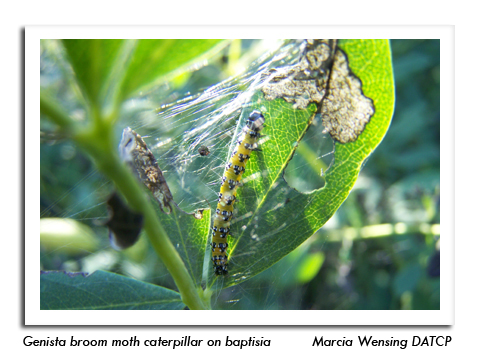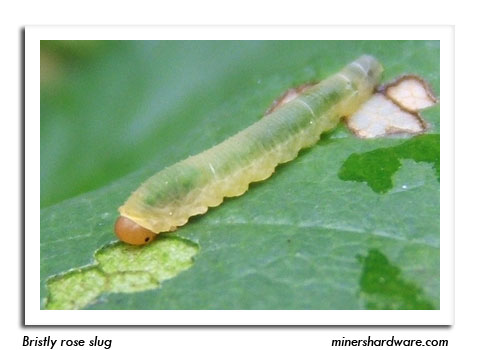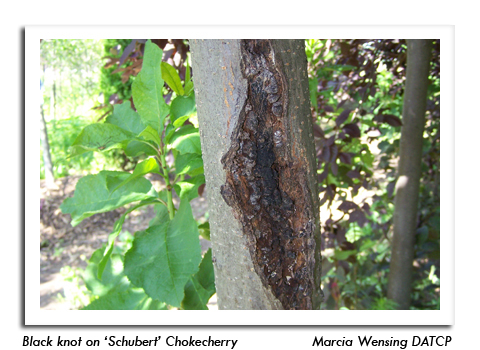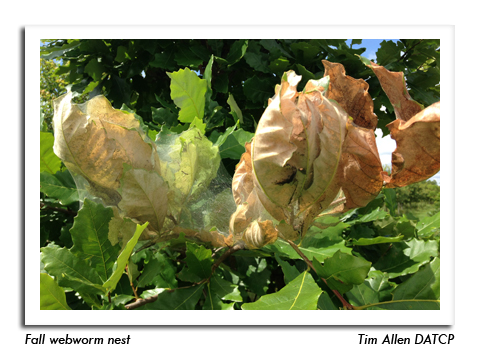
 |
|
|
Nursery & Forest
Volume 59 Number 13 Date 07/31/2014 GENISTA BROOM MOTH - Larvae of this typically southern species were observed feeding on baptisia (false indigo) in a Washington County nursery. The distinctive green or orange caterpillars with rows of clustered white hairs surrounded by black bands are voracious feeders that warrant control at any level of infestation. Small populations should be removed by hand, while larger infestations may require the use of Bt (Bacillus thuringiensis). Another option is to cut the baptisia back to a few inches, properly disposing of the cuttings and caterpillars. BRISTLY ROSE SLUG - The green, bristly larvae of this sawfly were feeding on the undersides of rose foliage in Barron and Polk counties this week, skeletonizing the leaves. Defoliation may be reduced by removing the larvae and infested leaves. Horticultural oils or residual insecticides are also effective. BLACK KNOT OF CHERRY - A light infection on cherry trees was noted at a nursery in Bayfield County. This common fungal disease is characterized by irregular, black swollen galls or 'knots' which form on branches and can range in size from ½ inch to one foot long. Shoots and branches bearing knots should be pruned in winter or early spring, before fungal spores are released. Multiple infections of black knot reduce tree vigor and cause eventual decline. Nursery trees with knots on the trunk must be removed from sale. SLUGS - Damage caused by these nocturnal mollusks was noted on daylily, disporopsis, hosta, ligularia and a variety of other perennials at nurseries and garden centers in Clark, Monroe, Ozaukee and Washington counties. Slugs are active at night and chew large, irregular holes in leaf tissue, stems and flowers of most any plant, often leaving behind slime trails. Many cultural control methods are available to reduce damage, including removing plant debris, boards or other materials or debris that may harbor slugs. Applying an abrasive material such as diatomaceous earth to the soil at the base of plants can also deter slugs. -- Ellen Hermanson, DATCP Nursery Inspector SPRUCE NEEDLE RUST - A small stand of declining Colorado blue spruce in eastern Oneida County was diagnosed with this rust disease late last week. The symptoms are pale, yellowish bands that surround new needles and whitish blisters filled with yellowish-orange spores that appear on current-year growth as the season progresses. Spruce needle rust has two hosts, alternating from Labrador tea to spruce in spring, and from infected spruce to Labrador tea in summer. Needles infected from the previous year will turn black or brown and eventually drop by the end of the growing season. Heavily infected trees lose vigor and aesthetic appeal and may die if other stressors are also present. Properly timed fungicide application could be used to reduce the effect of this pathogen. FALL WEBWORM - The characteristic nests constructed by larvae of this defoliator are apparent in Oneida County and across much of the state. Fall webworm is a native species which feeds on a wide range of deciduous forest, shade, fruit, and ornamental trees. Its nests or webs appear in trees at this time of year, later than nests made by other web- and tent-making species found in Wisconsin. The larvae inside the nests are pale yellow with blackish lateral spots. Those found in Oneida County were in the early instars and had black head capsules, but some forms also have reddish heads. Mature caterpillars develop tufts of silky hairs and are about one-inch long. This pest is primarily an aesthetic nuisance due to its unsightly webs, and is not known to cause tree mortality. Control consists of pruning or physical removal of the nests and larvae if aesthetic considerations are important. -- Tim Allen, DATCP Nursery Inspector EUROPEAN ELM SCALE - The Northwest Region nursery inspector reports that crawler stage of this insect is emerging in Polk County, where a heavy infestation was observed on the trunk of a Cathedral elm. European elm scale is a soft scale that produces sticky honeydew which drips onto plants, cars, sidewalks, and can be a serious nuisance. Of larger concern is the black sooty mold that develops on the honeydew and causes blackened branches, dieback, stunting, reduced tree vigor and defoliation. The brief period of crawler activity is expected to end by early August as the immature scales settle onto woody tissue for the remainder of their life cycle. There is one generation per year in Wisconsin. Horticultural oil, insecticidal soap, azadirachtin, carbaryl, malathion, or synthetic pyrethroids are all effective against the crawlers if applied during their mobile phase. Trees should be sprayed at least two times, once now and again in 2-3 weeks. -- Konnie Jerabek, DATCP Nursery Inspector GYPSY MOTH - The 2014 gypsy moth aerial spray season concluded July 25 with the treatment of 37,000 acres in Douglas and Rusk counties with mating disruptant. This year, approximately 187,500 acres were treated at 60 sites in 18 counties, mostly in the western part of the state. Aerial spraying started May 22 in southern Wisconsin and ended July 25 in the northern tier counties. Counties treated were: Barron, Bayfield, Chippewa, Crawford, Douglas, Dunn, Eau Claire, Grant, Green, Iowa, Jackson, La Crosse, Lafayette, Polk, Richland, Rusk, Sawyer and Trempealeau. Thirty-three sites totaling 19,000 acres were treated with Btk; 19 sites comprising 165,000 acres were treated with mating disruptant; and eight sites with a total of 3,850 acres were treated with Gypcheck, a gypsy moth-specific virus insecticide. Gypsy moth trappers continue to check the approximately 13,400 pheromone traps set in Wisconsin this season. Moth flight has been slow and sporadic as of late July, with about 1,500 moths caught so far, compared to roughly 6,000 at the same time last year. Program coordinators expect counts to increase significantly in coming weeks. All traps will be removed by the end of September. -- Rick Hummel, DATCP Gypsy Moth Program 





|
|
|